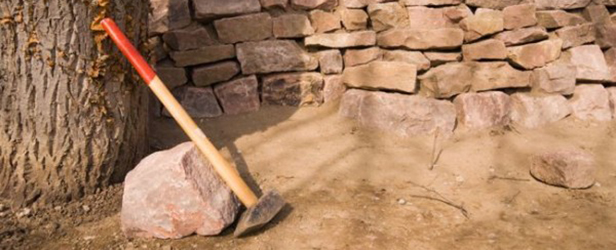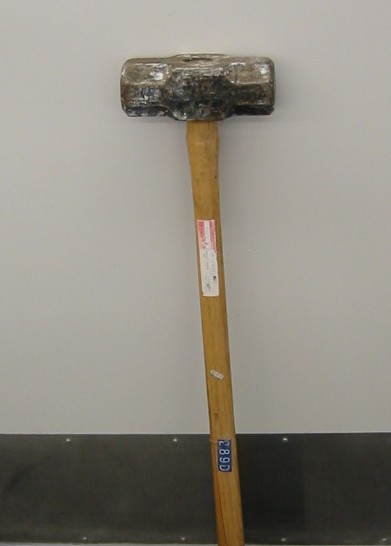
It’s a little after 11:00 p.m., and I’m still up watching last year’s World’s Strongest Man competition. Nevermind that I know who wins the whole thing. I just can’t get enough of watching these athletes throwing around insane amounts of weight. While you may have no desire to compete for the title of World’s Strongest Man or attain Phil Pfister’s physique, there is something to be said for their superhuman strength. While you may not have atlas stones in your backyard or a few 50-lb kegs to throw around the back of your gym wall, there is one tool I have found that not only helps in mimicking the demands of Strongman but will also add slabs of muscle in places you dare not dream.
There comes a time in every lifter’s life when he has to address his weaknesses. They may not even be weaknesses, but being pretty good at something just isn’t good enough anymore. So I have a list of things to work on—grip strength (for my deadlifts), shoulder flexibility (because it’s healthy and I bench a lot), core strength (because you can never have enough), and work capacity (a component sometimes forgotten in traditional powerlifting and bodybuilding programs). And what tool can take care of all of those in only a few minutes after every workout with some added benefits as well? I give you the sledgehammer—your new best friend in reshaping your body. Voila!
After assessing my strength level and my current status as an aspiring competitive powerlifter, I noticed a few weak points I needed to start addressing in my training sessions. My grip strength sucked. This is a common weakness for most trainees if you don’t train your grip directly. It’s often a limiting factor in your other lifts such as weighted pull-ups/chin-ups or in my case the deadlift.
My core strength wasn’t where I wanted it to be. Sound familiar? It should because it’s a problem with 90 percent of trainees. Whether it’s working the core incorrectly (i.e. wasted hours doing crunches on a Swiss ball), poor technique (i.e. round back lifting or too much reliance on a lifting belt), or in my case, shameful negligence, this is one weakness that you should pay attention to. An easy way I was able to notice this was in my back squat. While squatting twice my body weight isn’t a problem, for me, the “heavy” part of the squat comes with getting the bar off the hooks and set to go down. After reading about this in another article, I realized I needed to bring my core strength way up. While it’s good, good just isn’t good enough anymore.
I also wanted shoulders. While training like a powerlifter entails a lot of benching which covers a lot of shoulder work already, I wanted to target them more directly to give them that fuller, Dwight Howard-esque type of look. While this doesn’t really serve a functional purpose, there’s nothing like a healthy set of deltoids to really fill out a shirt. Sledgehammer work not only builds strength and size in the shoulders, but it also increases upper body mobility! I guess it does serve a functional purpose after all. Who says there’s no room for that in a strength/mass building program?
Additional Benefits
- If you opt for the full body swing, which entails that you use your hips more to power through the whole movement rather than keeping your feet glued to one spot, sledgehammer work does wonders for your hips. That rotation would do wonders for any sport that requires powerful hips (i.e. golf, tennis, baseball, hockey).
- Besides your shoulders, forearms, and lungs burning by the end of a session of sledgehammer work, your lats will be right there begging for mercy as well, and you’ll also be getting some great back work in (the hits just keep coming don’t they…pun intended).
While you may not have the desire to train like a powerlifter or be a Strongman competitor, I’ll go out on a limb and guess that if you frequent this site, you’re interested in being a strong man or woman at the very least. I can think of few things as manly and intimidating as swinging a heavy sledgehammer around and smashing into something repeatedly.
The Routine
It’s simple. The only other thing you’ll need is some sort of timer for this one. You’ll be working continuously for time rather than trying to go for a set number. By working for time, it adds the element of conditioning to your session. I also believe it keeps you more focused on what you’re doing and allows you to do more because you may be tempted to pack it in when you have a certain number of reps in mind. This is just my opinion, as the mental aspect of weight training intrigues me just as much as the physical aspect, and doing things according to time can definitely wear you out mentally.
*Note: This is very high intensity, so I recommend 2–4 sessions where you keep the work to rest ration of 1:1 for as long as you can. For the severely deconditioned, use a 1:2 or 1:3 work to rest ratio as needed.
Sledgehammer work isn’t overly time consuming, so there’s less of an excuse about fitting it in your cardio for the day. You’ll want to do a minimum of two sessions per week either as a finisher to your current regimen or use one of them on a separate day to burn some extra calories with some supplementary work (i.e. farmer’s walks). Each session will have a conditioning aspect to it in which you’ll be working for a set amount of time and rest only half that. One day will be short work, short rest (SW/SR), and the second day will be long work, long rest (LR/LR). Both are relatively close in total amount of time for each session, as they average out to 5.5 minutes of work. However, where one uses relatively short work periods with an equally low short rest period, the other session uses double the amount of time in work and rest though with fewer rounds (had to compromise somehow). Each is grueling in its own way so don’t be fooled by LW/LR’s use of only three rounds in week 1. Two minutes straight of nonstop tire hitting will hurt if you’re really pushing yourself!
There are two ways to progress from week to week with this routine—increase the number of rounds and keep the rest intervals constant or decrease the rest interval and keep the number and time of rounds constant. Either one will work and keep progress coming.
Below are both examples:
Option A
Week 1:
Monday (SW/SR): 5 X 60 seconds (30 seconds rest)
Thursday (LW/LR): 3 X 120 seconds (60 seconds rest)
Week 2:
Monday: 6 X 60 seconds (30 seconds rest)
Thursday: 4 X 120 seconds (60 seconds rest)
Week 3:
Monday: 7 X 60 seconds (30 seconds)
Thursday: 5 X 120 seconds (60 seconds)
Option B
Week 1:
Monday (SW/SR): 5 X 60 seconds (30 seconds rest)
Thursday (LW/LR): 3 X 120 seconds (60 seconds rest)
Week 2:
Monday: 5 X 60 seconds (20 seconds rest)
Thursday: 3 X 120 seconds (50 seconds rest)
Week 3:
Monday: 5 X 60 seconds (15 seconds)
Thursday: 3 X 120 seconds (45 seconds)
Option C
Once you’ve gotten past your love affair with HIIT, you can just smash away for however long you can. I didn’t bring a timer with me one day so I just went for a certain amount of reps (strange how the number 300 just suddenly came to mind while listening to Nine Inch Nails). I completed it in eight minutes and 40 seconds, and I was pretty spent. No set work to rest ratio. Just keep going until you’ve hit a certain number of reps or time (ten minutes total for the day usually works best). It’s nothing fancy. It’s just good old fashioned work that will burn some extra calories and keep the muscle gains coming.
If you decide to go forward with option C, you progress EDT style—either more hits in the same amount of time or take less time to do the same amount of hits. In either case, you set the bar for yourself each time, something I’ve always loved about this training concept.
But what if I don’t have a sledgehammer and tire? If you don’t have a tire to bang on, you can do it Rocky II style and smash some rusty old steel. If you have neither a sledgehammer nor a tire, find one! They’re cheap if you go to a junkyard. If you can’t, there’s still hope. You can still use the alternative found in almost every commercial training facility—heavy medicine balls. Just swing and slam in the exact same fashion as you would with a sledgehammer. Just watch out when it springs back at you (believe me from personal experience). While it’s obviously a greater concern with a sledgehammer, I’ve seen it happen on more than one occasion with a medicine ball.
One advantage medicine balls have over the sledgehammer is the grip. Because your hands will be on the sides of the ball rather than alternating positions with a sledgehammer, you’ll actually get some extra work for your chest as well. Granted it isn’t as intimidating slamming a yellow medicine ball with techno music playing in the background, but it will get the job done nonetheless. At the very least, you’ll have that section of the gym all to yourself because no one’s going to want to come near you.
So here’s proof again that it doesn’t take a lot of time or expensive equipment to get to your training goals. If they ever come out with a DVD series of the World’s Strongest Man, I have to get it. Their display of strength and power with utter aggression behind it still just makes me want to go out and smash something. Hide your commercial gyms!









